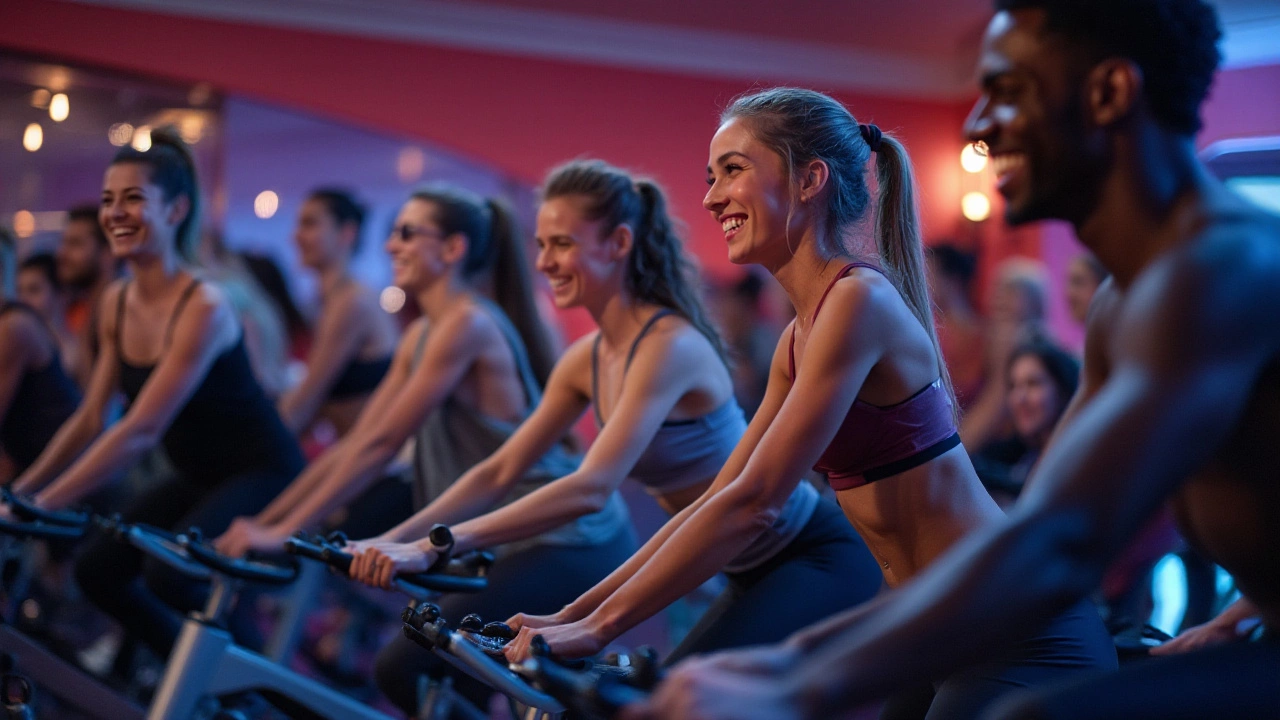
Losing weight quickly in two weeks through cardio is possible with the right approach and determination. Cardio exercises play a vital role in burning calories and boosting your overall fitness. Whether you're a beginner or seasoned at working out, there's a cardio routine out there that can fit your style and pace.
You'll discover how to tailor your cardio efforts for maximum impact, from high-intensity interval sessions to fun, engaging exercises that don't feel like a chore. It's not just about hitting the treadmill; there are plenty of creative ways to keep things interesting while you meet your goals.
As you embark on this two-week journey, staying motivated is key. With helpful tips and fascinating facts sprinkled throughout the article, you're in for a burst of motivation and knowledge that goes beyond mere steps in a workout.
- Understanding Cardio
- High-Intensity Interval Training
- Fun and Engaging Cardio Exercises
- Maximizing Your Efforts
Understanding Cardio
Cardiovascular exercise, often referred to simply as cardio, is a cornerstone of fitness routines, known for its effectiveness in promoting weight loss and enhancing heart health. At its core, cardio involves engaging in physical activities that raise your heart rate and keep it elevated for an extended period. This type of exercise ramps up your metabolism, leading your body to burn more calories, which is essential for shedding unwanted pounds. Whether you're running, cycling, swimming, or jumping rope, the primary goal remains the same: to get your heart pumping. It is this elevated heart rate that differentiates cardio from other exercise forms like strength training or Pilates.
When we talk about cardio, it’s crucial to understand the various intensities and types available. There's steady-state cardio, which involves maintaining a consistent pace over longer durations, perfect for beginners building their endurance. On the other end of the spectrum, you have high-intensity interval training (HIIT), which alternates between short bursts of intense activity and periods of rest. Studies suggest that HIIT can be particularly effective for weight loss, as it not only burns a significant number of calories in a short period but also keeps your metabolic rate elevated long after the workout is over. Renowned fitness coach Jane Doe once said,
"The beauty of cardio lies in its versatility. There's a form of cardio for everyone, no matter your fitness level or preference."
Adding a variety of cardio exercises into your routine can also help in beating workout monotony. Different activities engage different muscle groups, offering a full-body workout over time and reducing the risk of overuse injuries. Did you know that moderate-intensity cardio performed for just 150 minutes per week can significantly enhance cardiovascular health, according to the American Heart Association? It’s a testament to how integrating consistent cardio into your lifestyle can yield remarkable health benefits. For those looking to lose weight, creating a weekly plan that combines various forms of cardio workouts can be both effective and enjoyable.
Interestingly, the intensity at which you perform cardio can have different effects on your body. While the old myth suggested long sessions of low-intensity cardio are the best for fat loss, modern research has shown the benefits of short, intense sessions. A meta-analysis published in the Journal of Sports Medicine found that individuals engaging in HIIT lost up to 28.5% more weight than those participating in moderate-intensity continuous training. Understanding these nuances empowers you to tailor your workout plan to best suit your goals and lifestyle. Therefore, having a varied cardio plan might not only accelerate weight loss but also keep your workouts fresh and dynamically engaging.

High-Intensity Interval Training
High-Intensity Interval Training, or HIIT, is the go-to workout method for those seeking to lose weight efficiently in a short timeframe. Imagine alternating between bursts of intense activity and short recovery periods. This approach is not just a workout style; it’s a lifestyle choice that maximizes calorie burn and increases your metabolic rate even after the workout ends. The magic of HIIT lies in its ability to push the body into a state known as excess post-exercise oxygen consumption (EPOC), meaning your body continues to burn calories long after your workout session has wrapped up.
During a HIIT session, you might find yourself sprinting at full speed for a minute, then walking briskly for two minutes. The intensity of your effort should be so high that you’re challenging your limits during those explosive intervals. The beauty of HIIT is its adaptability to any fitness level. Beginners might begin with a simple mix of jogging and brisk walking, progressing to more vigorous activities as fitness improves. The method's versatility doesn't end there; HIIT can be applied to various types of cardio workouts, whether it be running, cycling, rowing, or even on an elliptical machine.
Scientific studies back the efficacy of HIIT, showing remarkable results in both weight reduction and cardiovascular health improvement. According to the American College of Sports Medicine, just two weeks of high-intensity intervals can improve your aerobic capacity as much as six to eight weeks of endurance training. A neat benefit of HIIT is time efficiency. With typical sessions lasting anywhere from 15 to 30 minutes, it's perfectly suited for those with busy schedules yet eager to expel as many calories as possible. Glen Gaesser, an exercise physiology professor at Arizona State University, once remarked,
“The overwhelming evidence supports the fact that even short bouts of very vigorous exercise can have tremendous benefits.”
If you're looking to incorporate HIIT into your routine, remember that structure plays a key role. Typically, a HIIT workout involves a warm-up period, followed by several sequences of high-intensity effort alternated with recovery times, and concludes with a cool-down. A sample structure might look like this:
- Warm-up: 5 minutes of light jogging or brisk walking.
- Intervals: 10-15 rounds of 30 seconds sprinting and 90 seconds of walking or light jogging.
- Cool-down: 5 minutes of stretching and deep breathing exercises.
It's vital to listen to your body throughout each session. Pushing the boundaries is part of the process, but overexertion can lead to injury. Ensure you're adequately hydrated and take rest days between HIIT workouts to allow your muscles to recover. As enticing as the promise of quick results is, remember that consistency and balance are necessary to prevent burnout and keep your passion for mastering your health goals alive.

Fun and Engaging Cardio Exercises
Finding ways to make cardio exercises enjoyable can truly transform your approach to fitness. By incorporating light-hearted, yet effective activities into your routine, you'll be more likely to stick with your weight loss plan and actually look forward to each session. For instance, jumping rope might remind you of childhood games, but it's a powerhouse when it comes to burning calories. In just ten minutes, you can burn as much as an eight-minute-mile run. This high-impact exercise improves your coordination and is extremely portable, making it easy to fit into a busy schedule.
Another excellent option is dancing, which doubles as a social activity as well. Whether you're swaying to Zumba beats or trying out new TikTok moves, dancing provides a whole-body workout that torches calories while lifting your spirits. An hour of dancing can burn hundreds of calories; it’s no wonder so many fitness studios include it in their schedules. According to the American Council on Exercise, depending on intensity, dancing can burn more than 500 calories per hour, making it a fantastic cardio choice.
Swapping indoor to outdoor activities can keep things fresh and exciting, too. Running on nature trails, for instance, offers a dynamic and scenic alternative to a treadmill workout. You engage different muscles when maneuvering through varied terrains, and the beauty of nature often provides extra motivation to go that extra mile. Cycling is another invigorating option that serves the dual purpose of exercise and transportation. You can track your distance and set goals to gradually increase your ride lengths.
Organized sports like basketball or tennis are not only refreshing but also social, allowing you to get fit while having fun with friends. These sports offer the combination of cardiovascular health and muscular endurance. In basketball, continuous movement and quick sprints make for a fantastic workout, while tennis focuses on agility and speed. A study from Harvard Health Publishing mentions that an hour of these sports could burn over 600 calories depending on one's weight and intensity level. For group lovers, joining a local league can add a healthy dose of competition and camaraderie to your workouts.
"Exercise shouldn't be about punishing your body for what you've eaten. It should be about celebrating your body for what it can do," says Jillian Michaels, a renowned fitness expert.
Let’s not forget about swimming, which is perfect for those seeking a low-impact yet effective cardio exercise. As a full-body workout, swimming not only improves heart health but also strengthens muscles without straining the joints. With so many strokes and styles to choose from, each lap becomes a part of a fun challenge. The buoyancy of water supports your body weight, making it suitable for all fitness levels and ages.
At the end of the day, the best cardio exercise is the one you enjoy the most. Whether you're shaking it up on the dance floor, hitting the court, or riding through town, consistency is key. Engaging in activities you love helps maintain motivation and creates a positive association with staying active. Before you know it, these cardio workouts will not just be about losing pounds fast, but also about embracing a healthier lifestyle that you genuinely enjoy.

Maximizing Your Efforts
When it comes to shedding pounds effectively with cardio, the strategy you adopt can greatly enhance your results. Start by ensuring your workouts encompass a variety of exercises that target different muscle groups. This not only helps boost calorie burn but also prevents your body from adapting too quickly, which could slow down your weight loss progress. Experts suggest varying your routines every few days by switching from high-intensity interval training to steady-state cardio sessions. Mixing up your cardio workouts keeps them challenging and engaging, making it easier to stick to your two-week plan.
Pay attention to your body's signals. It's tempting to push through exhaustion for the sake of burning extra calories, but recognizing when your body needs rest is crucial. Rest allows your muscles to recover and grow stronger, which in turn boosts your metabolism. Regularly incorporate rest days, and don't hesitate to cut back if you feel overly fatigued or stressed. An effective way to monitor your progress and adjust your workouts is by maintaining a workout diary. This tool helps track not only the exercises you've completed but also your energy levels, allowing you to identify patterns and effective strategies.
Focusing on the nutritional side is equally important. Cardio exercises are more effective when combined with clean eating habits. Stay hydrated and choose foods rich in protein and fiber, as they help fuel your workouts and promote satiety. It's vital to balance your calorie intake. Fuel your body with nutrient-dense foods before and after workouts to optimize energy levels and recovery. With a strategic combination of exercise and nutrition, you're more likely to see meaningful progress within your two-week timeframe.
"The combination of cardiovascular exercise and healthy eating is a powerful duo for achieving weight loss goals," says Dr. Andrew Reynolds, a leading nutritionist, highlighting the importance of a balanced approach.
Consider integrating technology to track your workouts and measure your progress. Wearable fitness devices and mobile apps can be great companions in this journey. They not only provide insights into the calories you're burning but can also motivate you by setting daily goals and reminding you to move. The feedback loop created by technology can provide just enough push to make those last few steps or complete those workout sessions you might otherwise skip.
Staying motivated can be a challenge, especially if the results aren't immediately visible. Set realistic and achievable goals to keep your spirits high throughout your weight loss journey. Remember that each step, each increase in stamina, and each drop of sweat is a step toward a healthier you. Engage with a community, be it through online groups or local fitness clubs, as sharing your journey can bring encouragement and fresh perspectives. Together, with a commitment to staying active and attentive to your body's needs, you can maximize the impact of these cardio workouts and achieve meaningful changes in just two weeks.
